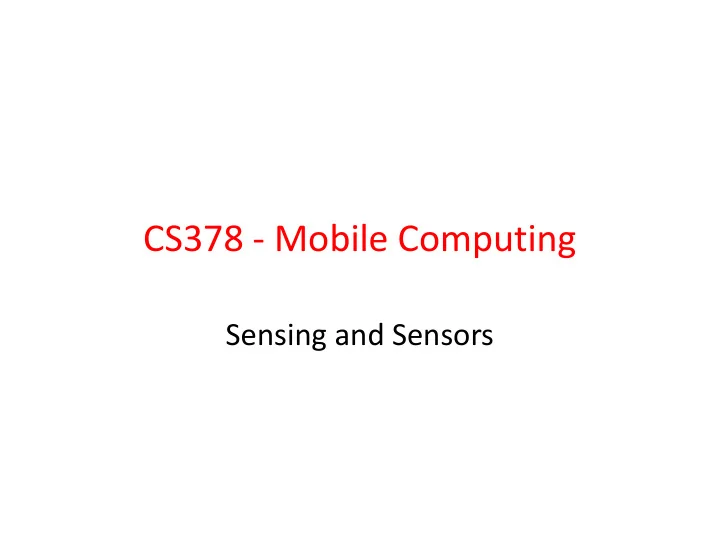

CS378 - Mobile Computing Sensing and Sensors
Sensors • "I should have paid more attention in Physics 51" • Most devices have built in sensors to measure and monitor – motion – orientation (aka position) – environmental conditions • sensors deliver raw data to application 2
Using Sensors - Basics • Obtain the SensorManager object • create a SensorEventListener for SensorEvents – logic that responds to sensor event – various amounts of data from sensor depending on type of sensor • Register the sensor listener with a Sensor via the SensorManager 3
Sensor Coordinate System • For most motion sensors: • +x to the right • +y up • +z out of front face • relative to device 4
Sensor Coordinate System • App that displays max acceleration along each axis • Hold phone straight up and down and move to ground 5
Sensor Coordinate System • Repeat but hold … then sideways phone flat 6
Types of Sensors • Not every device has every kind of sensor • Constants from Sensor class • TYPE_ACCELEROMETER – hardware – acceleration force in m/s 2 – x, y, z axis – includes gravity 7
Types of Sensors • TYPE_AMBIENT_TEMPERATURE – hardware – "room" temperature in degrees Celsius – no such sensor on dev phones • TYPE_GRAVITY – software or hardware – just gravity – if phone at rest same as TYPE_ACCELEROMETER 8
Types of Sensors • TYPE_GYROSCOPE – hardware – measure device's rate of rotation in radians / second around 3 axis • TYPE_LIGHT – hardware – light level in lx, – lux is SI measure illuminance in luminous flux per unit area 9
Types of Sensors • TYPE_LINEAR_ACCELERATION – software or hardware – measure acceleration force applied to device in three axes excluding the force of gravity • TYPE_MAGNETC_FIELD – hardware – ambient geomagnetic field in all three axes – uT micro Teslas 10
Types of Sensors • TYPE_ORIENTATION [deprecated] – software – measure of degrees of rotation a device makes around all three axes • TYPE_PRESSURE – hardware – ambient air pressure in hPa or mbar – force per unit area – 1 Pascal = 1 Newton per square meter – hecto Pascals (100 Pascals) – milli bar - 1 mbar = 1hecto Pascal 11
Types of Sensors • TYPE_PROXIMITY – hardware – proximity of an object in cm relative to the view screen of a device – most just binary (see range, resolution) – typically used to determine if handset is being held to person's ear during a call • TYPE_RELATIVE_HUMIDITY – ambient humidity in percent ( 0 to 100) 12
Types of Sensors • TYPE_ROTATION_VECTOR – hardware or software – orientation of device, three elements of the device's rotation vector • TYPE_TEMPERATURE – hardware – temperature of the device in degrees Celsius 13
Availability of Sensors 14
Listing Types of Sensor on Device 15
Types of Sensors - Dev Phone • accelerometer, linear acceleration, magnetic field, orientation, light, proximity, gyroscope, gravity 16
Sensor Capabilities • Various methods in Sensor class to get capabilities of Sensor • minDelay (in microseconds) • power consumption in mA (microAmps) • maxRange • resolution 17
Sensor Capabilities - Dev Phones 18
Getting Sensor Data • registerListener – sensorEventListener – Sensor -> obtain via SensorManager – rate of updates, a hint only, or microseconds (not much effect) • returns true if successful 19
SensorEventListener 20
Display Max Recall, max range of linear acceleration on dev phone is 19.613 + gravity = 29.423 - a baseball pitcher throwing a fastball reaches 350 m/s 2 or more (various "physics of baseball" articles) 21
Display Current • Lots of jitter • Attempt to zero out 22
Accelerometer - Includes Gravity • Sensor. TYPE_ACCELEROMETER • Device flat on table • g ~= 9.81 m/s 2 23
Linear Acceleration • At rest of table • Recall • units are m/s 2 24
Zeroing out • Take average of first multiple (several hundred) events and average – shorter time = more error • Potential error – should be 0 at rest • Results: 25
Rate of Events • 1000 events • SensorManager.SENSOR_DELAY_UI – times in seconds: 21, 21, 21 – 21 seconds / 1000 events • SensorManager.SENSOR_DELAY_FASTEST – times in seconds: 21, 21, 21 • Recall delay of 20,000 micro seconds • 2x10 4 x 1x10 3 = 2x10 7 = 20 seconds 26
Recommend
More recommend